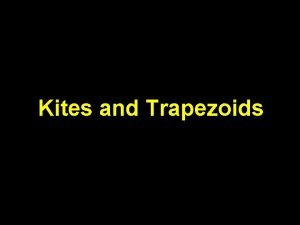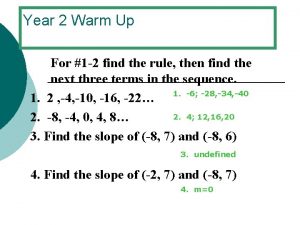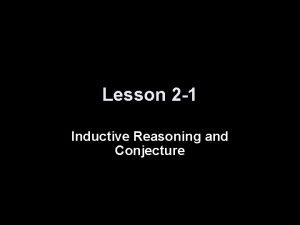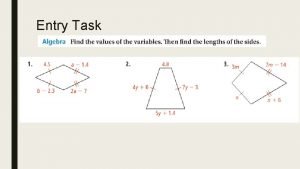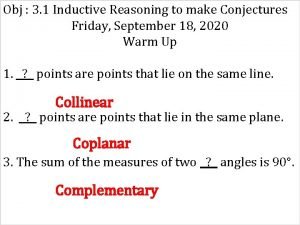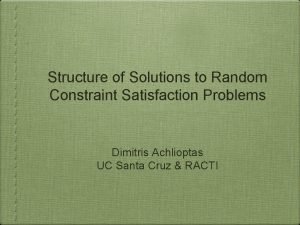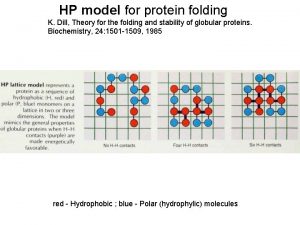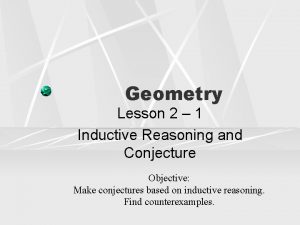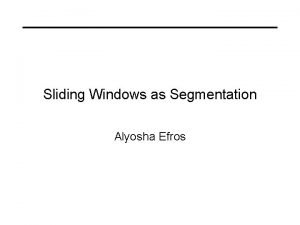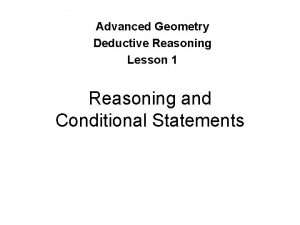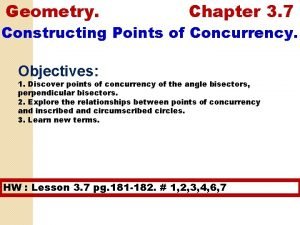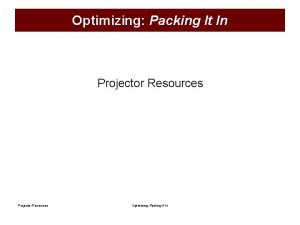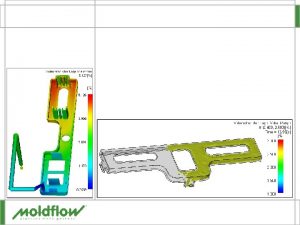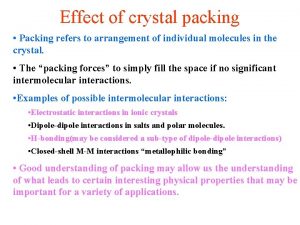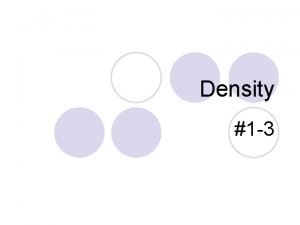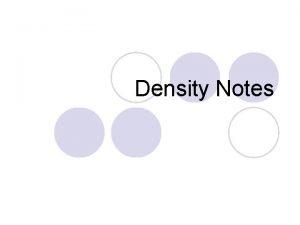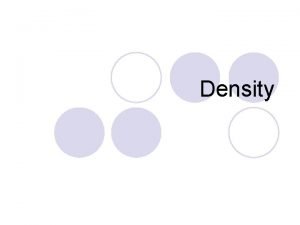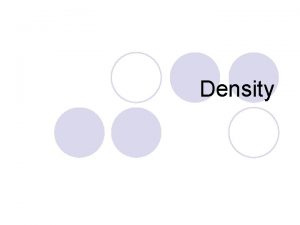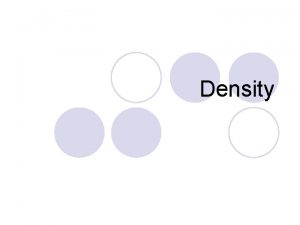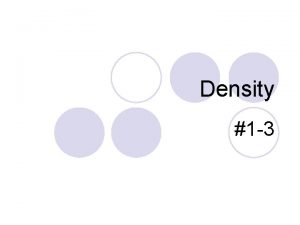A Conjecture for the Packing Density of 2413





















































- Slides: 53

A Conjecture for the Packing Density of 2413 Walter Stromquist Swarthmore College (joint work with Cathleen Battiste Presutti, Ohio University at Lancaster) PP 2007 St. Andrews, Scotland June 12, 2007


Outline 1. About packing densities 2. Packing rates for measures: a. There is an optimal measure for every pattern b. Packing rate = Packing density 3. An optimal measure for 2413: the best we can do without recursion 4. Amazing things happen with recursion bubbles 5. Conjecture for 2413: 0. 10472422757673209041…

About packing densities… A pattern is a permutation in Sm. Let n Sn. An occurrence of in n is an m-element subsequence of n that has the same order type as . reduces to . Define The packing density of in n is Clearly,

About packing densities… We’re concerned with permutations n Sn that maximize the packing density ( , n ). So, define: Any permutation n* that achieves this maximum (for a given size n) is called an optimizer for (or, optimizing permutation). The packing density of is the limiting value, (It always exists. )

About packing densities… Equivalently: The packing density of is the largest number D such that there is a sequence of permutations of increasing size such that The n ‘s don’t have to be optimizers; they just have to be close enough that they have the right limit.

Describing the near-optimizers Here’s how we describe good n‘s for 132: That’s what the n‘s look like. The packing density turns out to be

Describing the near-optimizers Here’s an easier picture: The points line up along these lines. This object is a probability measure on the unit square. Let’s formalize it.

Measures on the Unit Square Let S be the unit square, S = [0, 1] R 2. A probability measure on S is a probability distribution on S. If a point is selected randomly according to , then (A) is the probability that the point is in A. is non-negative and countably additive. Also, (S) = 1. All measures in this talk are probability measures on S.

The packing rate for a measure Let m be a pattern, and let be a measure. If m points are selected randomly according to , then the packing rate of with respect to is the probability that the order type of their configuration is . We denote this packing rate by ’ ( , ). More precisely: Let m = … be the product measure on S m = S S … S. Let A Sm contain all m-tuples of points that form configurations with order type . Then ’ ( , ) = m ( A ).

“…order type of their configuration…” If the points are ordered by increasing x coordinates, x 1 < x 2 < … < x m, then the order type of the configuration is the order type of their y coordinates ( y 1, y 2, …, ym ). The order in which the points are selected is irrelevant. If any two points have the same x coordinate or the same y coordinate, then the configuration has no order type. These four points have order type 2314.

Examples of packing rates Example. Let be the uniform measure on S. Then all order types are equally likely. We therefore have ’ ( 123, ) = 1/6 and, in general, ’ ( , ) = if has size m. 1 / m! Points are drawn uniformly from the unit square.

Examples of packing rates Example. Let be concentrated along the main diagonal. Then ’ ( 123, ) = 1 and ’ ( , ) = 0 for any other pattern of size 3. It doesn’t matter how probability is distributed along the diagonal.

Examples of packing rates Example. Let be concentrated along countably many diagonal segments as shown. Then ’ ( 132, ) = This is the packing density of 132. No other measure gives a higher packing rate for 132. This is the “optimal measure” for 132.

Examples of packing rates Example. Let be uniform on a disk in S. WHAT IS ’ ( 123, ) ? Points are drawn uniformly from the disk.

Optimal Measures Given a pattern , the optimal packing rate of (or just the packing rate of ) is ’( ) = ( ’ ( , ) ) where the supremum is taken over all measures. Any measure that realizes the supremum is called an optimal measure for . Does every pattern have an optimal measure ? YES.

Optimal Measures Is there always an optimal measure? Why not just find measures i whose packing rates approach the maximum, and take the limiting measure? (1) It’s tricky to define limiting measures (2) Limits of measures don’t always preserve packing rates

Limits of measures If i is a measure for each i and is a measure, we say that = lim i if for every continuous function f on S. With this definition, the set of probability measures on S forms a compact topological space. So, for any sequence { i} of measures, there is a subsequence { i} with a limit = lim i. But the packing density of is not always equal to the limit of the packing rates of the i’s.

Example – limits don’t preserve packing rates In this picture, = lim i. But ’ ( 132, i ) = 1/6 for each i, while ’ ( 132, ) = 0. n is concentrated on [ 1/(n+1), 1/n ]2 is a point mass at the origin

Normalized Measures A measure on S is normalized if its projections on both the x and the y axis are uniform distributions. A limit normalized measures is normalized. If the measures i are all normalized and = lim i then ’ ( , i ) = lim ’ ( , i ). Every measure can be normalized by monotone transformations of the x and y coordinates. This operation can’t reduce packing rates.

Every pattern has an optimizing measure Theorem: For every pattern , there is a measure such that ’ ( , ) = ( ’ ( , ) ) = ’( ). The measure can be chosen to be normalized. Proof: Pick measures { i} whose packing densities approach the supremum. Replace them with normalized measures { i}. Find a subsequence that converges to a limit measure . Then is normalized, and is an optimizing measure for . // Question: Is the normalized optimal measure for always unique? (Probably not, but it would be very nice if it were. )

Packing rates = Packing densities Theorem: The optimal packing rate of any pattern is its packing density: ’ ( ) = ( ).

Packing rates = Packing densities Why ( ) ’ ( ) : Given any measure , just pick n randomly according to . Then on average the packing rate of in n is exactly ’ ( , ). So, we can pick particular n‘s that achieve this average, and then we have lim ( , n ) = ’ ( , ). This forces ( ) ’ ( ).

Packing rates = Packing densities Why ’ ( ) : Find a sequence of measures n with lim ( , n ) = ( ). For each n , construct a template measure (Presutti, PP 2006): Now the limit of the template measures (or of some subsequence of them) is a measure with ’ ( , ) = ( ). So ’ ( ).

Summary For every pattern that maximizes For that measure, , there is a normalized optimizing measure ’ ( , ) = ( ). So, to find the packing density, it suffices to find an optimizing measure.

About 2413… Why 2413 ? (1) Least-understood pattern of size 3 or 4 (2) As far as possible from being layered What we know… ( 2413 ) 6/64 = 0. 09375 ( 2413 ) 51/511 = 0. 099804… ( 2413 ) 0. 104250980… Upper bound: ( 2413 ) 2/9 (because that bound works for any of size 4) (AAHHS, template of size 8) (Presutti, weighted template of size 16) (AAHHS, not likely tight) Today’s conjecture: ( 2413 ) ≈ 0. 10472422757673209041…

An optimal measure for 2413 ? So, what is an optimal measure for 2413? By symmetry and computational experience, we suspect a measure of this form:



Distribution need not be uniform

Probability distribution along this line: F(t) t=0 ……………. t=1 F(t) = fraction of this segment’s probability that is in the leftmost fraction t of the segment

Symmetrical Four-Segment Measures (1) Probability is concentrated along the four segments shown (2) Measure has four-fold rotational symmetry (3) Measure is partially normalized … combined mass of top and bottom segments is uniform on [1/4, 3/4], and similarly for side segments F(t) + ( 1 – F(1 -t) ) = 2 t for t in [0, 1] Values of F on [0, ½] determine all of F

Examples of Symmetrical Four-Segment Measures Example: F(t) = t (for all t) --- probability is uniform along all four segments. packing rate is 6/64. (Not obvious!) Example: F(t) = 0 for t in [0, ½], 2 t-1 for t in ( ½, 1] --- probability is uniform along outer half of each segment packing rate is 6/64 ( four points form an instance of 2413 iff one point is on each segment )

F

Examples of Symmetrical Four-Segment Measures Example: F(t) has slope 0 in [ 0, ¼ ] and [ ½, ¾ ] slope 2 in [ ¼ , ½ ] and [ ¾, 1 ]. packing rate is 51/512 ( this is essentially the AAHHS estimate )

F

Examples of Symmetrical Four-Segment Measures Example: F(t) = t 2 for t in [0, 1] packing density = 349/3360 ≈ 0. 103869… (Better than 51/511 ≈ 0. 099804…, but not as good as the current record) …This shows that there may be some advantage to an uneven distribution.

Packing rate calculated from F… Theorem. Let be a symmetrical four-segment measure with the distribution along each segment given by F. Then the packing rate is given by

How would one prove such a formula? There are three possibilities for 2413 -patterns arising from One point per segment …works only if right dot is above left dot, and bottom dot right of top dot Two, one : Two pairs

Chance of getting type 1 Probability of an occurrence of the first type: (1) Probability that points are in four different segments: 6/64 (2) Probability that right point is above left point:

Chance of getting type 1 (3) Probability that bottom point is to right of top point: Same as (2) (4) Therefore: Probability of type 1 occurrence of 2413: Calculate type-2 and type-3 probabilities similarly; add to get theorem.

Calculus of Variations Write: How do we choose F to maximize this value ? Theorem: Let above, then . If F maximizes the expression whenever F is not constrained at t. (That is, whenever the slope of F is not 0 or 2. )

So what is F ? The above formula gives a negative value when t < ¼ - 2 J. So the real formula is F(t) = 0 = formula above if t < t* = ¼ - 2 J, if t t* The above formula makes F dependent on J, which is an integral of F itself. The resulting condition determines J and t*: t* ≈ 0. 14779091617675321550… J ≈ 0. 05110454191162339225…

So what is F ? …so finally, F(t) is given by F(t) = 0 when t < 0. 14779091617675321550… otherwise.

Best packing rate ? This F gives ’ ( , ) ≈ 0. 10472339512772223636… which is a new lower bound for the packing density of 2413. Compare last year’s value, from weighted template: 0. 104250980…

Recursion bubbles But wait! This plan leaves about 14% of each segment empty.


With the recursion bubble… Recall packing rate so far: 0. 10472339512772223636… With one recursion bubble on each segment, the packing rate becomes… 0. 10472417578055968289… …A MASSIVE IMPROVEMENT !

Shouldn’t the recursion bubble be bigger? Shouldn’t it? The measure was optimal before we introduced recursion. Now, there’s more advantage to drawing points from the box than there was before. At the margin, isn’t that a reason for increasing the size of the bubble? So, make the bubble bigger. But then the low end of F is inconsistent. We need to add another recursion bubble to get F back on track. And then another, and another…


Best result with two bubbles One bubble: bubble ends at t =. 1477… packing density = 0. 10472417578055968289… Two bubbles: first bubble expands to t =. 15141… second bubble ends at t =. 15352… packing density = 0. 10472422757673209041…

How much proof, how much conjecture? We conjectured that the optimal measure is a symmetrical foursegment measure, with recursion bubbles inserted. We proved that the optimal four-segment measure is the one given, with ’( , ) ≈ 0. 10472339512772223636…. We proved that adding a single recursion box to each segment increases the packing density to 0. 10472417578055968289…. (So, that becomes a proven lower bound for the packing density. ) We calculated (using Mathematica “Maximize”) that the optimum with two recursion boxes is 0. 10472422757673209041…. We conjecture that the optimal measure contains an infinite string of recursion bubbles at each end of each segment, plus an interleaved section in the middle.

What next? Prove some of this stuff. Now that we know how rich optimal measures can be, go hunting for more good examples.
 Naca 2413
Naca 2413 Low packing density
Low packing density Planar atomic density bcc 111
Planar atomic density bcc 111 Arithmetic density ap human geography
Arithmetic density ap human geography What does arithmetic density tell us
What does arithmetic density tell us Linear density of fcc 110
Linear density of fcc 110 Specific gravity units
Specific gravity units Nda full dac
Nda full dac Vertex angle of a kite
Vertex angle of a kite Conjecture and counterexample examples
Conjecture and counterexample examples Conjecture definiton
Conjecture definiton Dodo bird conjecture
Dodo bird conjecture Vertical angle conjecture
Vertical angle conjecture Intersecting secants conjecture
Intersecting secants conjecture Onerous definition sentence
Onerous definition sentence Descartes evil demon hypothesis
Descartes evil demon hypothesis 2-1 inductive reasoning and conjecture
2-1 inductive reasoning and conjecture Kite angle
Kite angle Chronology protection conjecture
Chronology protection conjecture Using inductive reasoning to make conjectures
Using inductive reasoning to make conjectures Unique games conjecture
Unique games conjecture Dimitris achlioptas
Dimitris achlioptas Inscribed angle problems
Inscribed angle problems Grigori perelman paper
Grigori perelman paper Beal conjecture examples
Beal conjecture examples Hodge conjecture
Hodge conjecture Conjecture and counterexample examples
Conjecture and counterexample examples Sensitivity conjecture
Sensitivity conjecture Lesson 2-2 deductive reasoning
Lesson 2-2 deductive reasoning Overlapping segments conjecture
Overlapping segments conjecture Conjecture
Conjecture Conjecture and counterexample examples
Conjecture and counterexample examples Make a conjecture based on the given information
Make a conjecture based on the given information The incenter is the center of the __________ circle.
The incenter is the center of the __________ circle. Unique games conjecture
Unique games conjecture Poincare conjecture solver
Poincare conjecture solver Alternate interior angles conjecture
Alternate interior angles conjecture Equilateral/equiangular triangle conjecture
Equilateral/equiangular triangle conjecture Tack för att ni har lyssnat
Tack för att ni har lyssnat Läkarutlåtande för livränta
Läkarutlåtande för livränta Centrum för kunskap och säkerhet
Centrum för kunskap och säkerhet Inköpsprocessen steg för steg
Inköpsprocessen steg för steg Påbyggnader för flakfordon
Påbyggnader för flakfordon En lathund för arbete med kontinuitetshantering
En lathund för arbete med kontinuitetshantering Anatomi organ reproduksi
Anatomi organ reproduksi Egg för emanuel
Egg för emanuel Atmosfr
Atmosfr Standardavvikelse
Standardavvikelse Rutin för avvikelsehantering
Rutin för avvikelsehantering Presentera för publik crossboss
Presentera för publik crossboss Treserva lathund
Treserva lathund Myndigheten för delaktighet
Myndigheten för delaktighet Debatt mall
Debatt mall Kung dog 1611
Kung dog 1611








